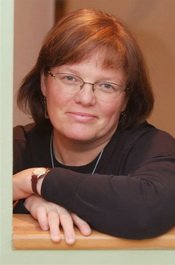Éva Szendrényi earned her degree in structural and civil engineering from the Technical University of Budapest's Faculty of Civil Engineering in 1984, then went on to graduate from the College of Theatre and Film Arts master's course in Theatre Technology Management in 1989. Between 1984 and 1989, she worked at the Theatre Technology Co-operative, taking part in the reconstruction of several theatres (those of Szeged, Kecskemét, Kaposvár, Pécs and Veszprém), and later worked as a scenic artist, first for the Madách Theatre (1989-1991), and then for the Hungarian State Opera (1991-1995). Since 1995, she has worked on a freelance basis. She taught set construction at the College of Theatre and Film Arts between 1991 and 1998 and set design at the Hungarian University of Fine Arts in 2002 and 2003.
Her more important set designs include those for Puccini's Turandot (National Theatre of Szeged, 1995), Boito's Mefistofele (National Theatre of Szeged, 1997), a reworked version of Rossini's Il barbiere di Siviglia (National Theatre of Szeged, 1998), Verdi's Simon Boccanegra (Csokonai Theatre Debrecen, 1999; National Theatre of Szeged, 2002), Puccini's Il trittico (National Theatre of Szeged, 2000), Verdi's Otello (National Theatre of Szeged, 2008), Le comte Ory (National Theatre of Szeged, 2009), Liszt's Don Sanche (Thália Theatre, 2011), Mozart's Le Nozze di Figaro (Szombathely, Iseum, 2012), Wagner's Der fliegende Holländer (Magyar Állami Operaház, 2013), Rameau's Hippolyte et Aricie (Hungarian State Opera, 2013), Offenbach's Orphée aux enfers (Müpa Budapest, 2015), Goldmark's Die Königin von Saba (Erkel Theatre, 2015), Bartók's Bluebeard's Castle (Shanghai, 2016), Kodály's Háry János (Müpa Budapest, 2015) and Offenbach's Die Rheinnixen (Erkel Theatre, 2018). At the Opera she design the sets for Ponchielli's La Gioconda and two short works being performed together on the same evenings: Jenő Kenesey's The Gold and the Woman and Péter Tóth's The Tót Family.
She received the Tivadar Márk Commemorative Plaque in 2016. In 2022 she earned the Noémi Ferenczy Award.
Her more important set designs include those for Puccini's Turandot (National Theatre of Szeged, 1995), Boito's Mefistofele (National Theatre of Szeged, 1997), a reworked version of Rossini's Il barbiere di Siviglia (National Theatre of Szeged, 1998), Verdi's Simon Boccanegra (Csokonai Theatre Debrecen, 1999; National Theatre of Szeged, 2002), Puccini's Il trittico (National Theatre of Szeged, 2000), Verdi's Otello (National Theatre of Szeged, 2008), Le comte Ory (National Theatre of Szeged, 2009), Liszt's Don Sanche (Thália Theatre, 2011), Mozart's Le Nozze di Figaro (Szombathely, Iseum, 2012), Wagner's Der fliegende Holländer (Magyar Állami Operaház, 2013), Rameau's Hippolyte et Aricie (Hungarian State Opera, 2013), Offenbach's Orphée aux enfers (Müpa Budapest, 2015), Goldmark's Die Königin von Saba (Erkel Theatre, 2015), Bartók's Bluebeard's Castle (Shanghai, 2016), Kodály's Háry János (Müpa Budapest, 2015) and Offenbach's Die Rheinnixen (Erkel Theatre, 2018). At the Opera she design the sets for Ponchielli's La Gioconda and two short works being performed together on the same evenings: Jenő Kenesey's The Gold and the Woman and Péter Tóth's The Tót Family.
She received the Tivadar Márk Commemorative Plaque in 2016. In 2022 she earned the Noémi Ferenczy Award.
